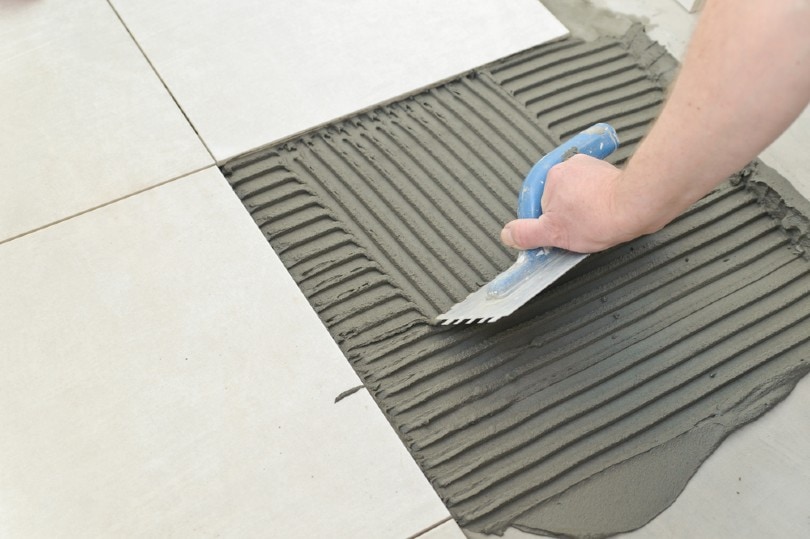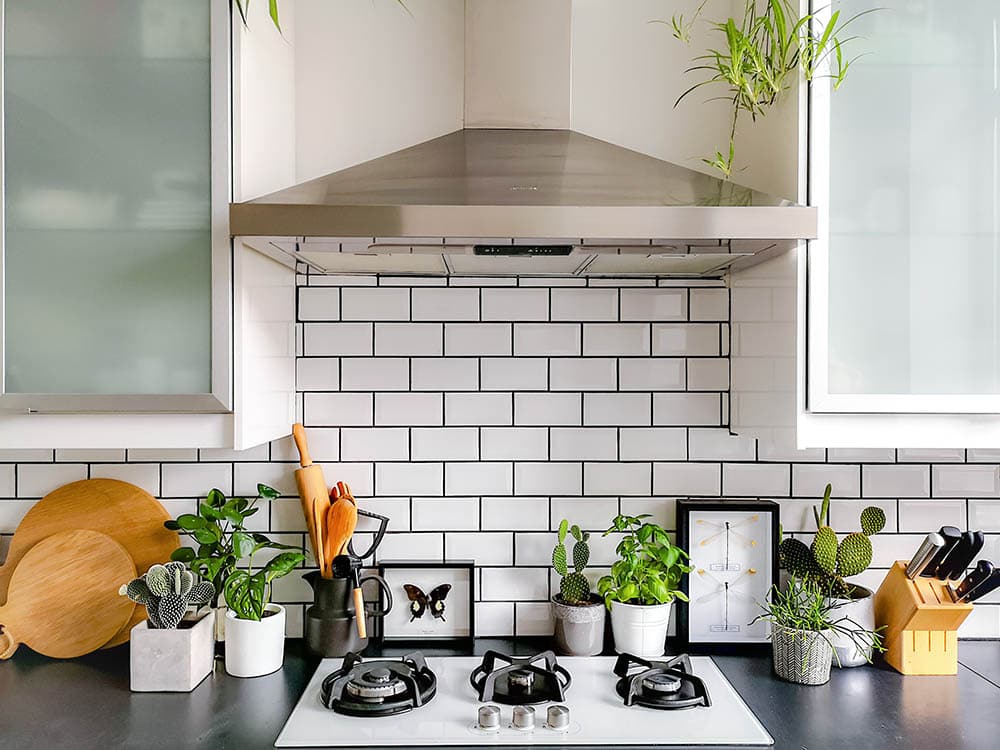Can You Use Floor Tiles on Walls? Differences & Tips
-
- Last updated:

As a homeowner, you might want to renovate or redesign your house every now and again. This would involve changing the tiles in your bathroom or toilet to keep them fresh and beautiful all year round. Floor and wall tiles may appear nearly identical, making people wonder if they can be used interchangeably. While almost all floor tiles can be used on walls, the reverse isn’t true. You should never install wall tiles on the floor.
Both floor and wall tiles have unique characteristics that make them suitable for their intended application. However, sometimes you can cross them over and use floor tiles on walls. Unfortunately, the reverse isn’t possible because wall tiles are not durable enough for foot traffic. They also lack texture which makes them slippery and, therefore, more dangerous.
This article will endeavor to demystify the differences between wall and floor tiles and help you make sense of the vast array of tiles on offer today. The article will also explore whether it is possible to use floor tiles on the wall and whether it is a good idea. Read on to learn more.

Considerations Before Installing Floor Tiles on Walls
For clarity, you should never install wall tiles on the floor, but you can always opt to go the other way. Manufacturers have a good reason why they separate floor and wall tiles, and it has everything to do with the weight of the tile. For interior designers to determine which type of tile goes to the wall, floor, or both, they use The British Standard for Wall Substrate Maximum Weight of Tiling per m2.
Different types of walls can handle different tile weights. So, if you want to match the floor tiles with the wall tiles, consider consulting the guide before making a purchase decision. Besides the tile weight, you also need to consider the heaviness of the adhesive or grout you will use to install tiles on the wall.
Usually, the choice to use floor tiles on walls is primarily influenced by aesthetics. So, people opt to use floor tiles on the wall even if the packaging is clearly labeled as floor tiles. This is mostly because tiles installed on the wall don’t necessarily need to be skid resistant or durable. So, literally, any type of tile can be installed on the walls of your home.

The Main Differences Between Floor and Wall Tiles
As you may have gathered, you can use floor tiles on walls but not vice versa. Whether to install a tile on a wall or the floor is determined by the Coefficient of Friction (COF)—the slipperiness rating—and the Porcelain Enamel Institute (PEI)—the rigidity rating.
Coefficient of Friction (COF) Rating
This factor determines where you should install a tile by telling you how much friction a tile has on its surface. The COF rating is assigned to every ceramic and porcelain tile produced. For a floor tile to be safe to walk on, it must have a specific type of friction. So, the COF is simply a measurement of friction, and higher numbers usually indicate more friction.
For a tile to be used for interior flooring, it should have a COF of at least 0.50 because this prevents slipping. If your household has a young child, pets, or anyone with mobility impairment, consider going for a tile with a higher COF rating.
Wall tiles on the other hand are not designed with the COF in mind because a wall being slippery is deemed a non-issue. However, issues will arise if you use a tile with a COF rating of less than 0.5 on the floor.
PEI (Porcelain Enamel Institute) Rating
The Porcelain Enamel Institute is the other factor that usually determines the durability and hardiness of tiles. The PEI is not as straightforward as the COF because tile manufacturing companies categorize durability and hardiness into five classes if they want.
The classification starts from class 1, which is ideal for walls and cannot handle foot traffic because it is made from lighter, more fragile materials. Class 5 ratings are given to tiles that can handle heavy foot traffic areas as found in commercial buildings. The PEI ratings are often hidden in the specs information of every tile retailing in stores and are a great indicator of where a tile may be installed.

The 6 Other Differences
1. Durability and Ability to Sustain Pressure
Floor tiles are manufactured to be resistant to wear and tear, durable, and able to sustain pressure. Wall tiles on the other hand are designed to be durable but do not have to handle as much pressure. This makes them significantly softer than floor tiles and can easily crack due to foot traffic.
So, floor tiles are ideal for both floor and wall installation, but wall tiles should only be used on walls. Both tiles have equal durability.

2. Manufacturing Process
During the manufacturing process, wall tiles are often given a hardened glazer on the top surface to make them impervious to water. They also feature a high-gloss finish, which is aesthetically pleasing but unsafe on the floor because it poses the risk of slipping.
Moreover, wall tiles often pack a variety of designs, inlays, and embellishments purely for decorative purposes. These features are lacking on floor tiles.
3. Usage and Maintenance
Wall tiles are usually exclusively used for wall installation because their design cannot handle heavy loads. Additionally, they are easy to clean and maintain. They are also suitable for areas with high moisture content such as bathrooms and toilets.
Floor tiles are designed to withstand abrasives, pressure, and corrosive liquids. Therefore, they can double up as wall tiles in high-traffic areas.
4. Heat Resistance
Both ceramic and porcelain tiles have great water and heat resistance. However, for countertop use, wall tiles may not be suitable because they are a bit thinner than floor tiles. Hence, they are less resistant to hot pans and skillets.
Since floor tiles are significantly thicker, they have more heat resistance and are better suited for countertop applications. However, heat resistance is not relevant for wall and floor installation.

5. Tile Installation
Both floor and wall tiles utilize the same method of tile installation. First, you will install a cement backer board on the subfloor then tiles are bonded with the board with thin-set adhesives that are applied using a special notched trowel.
Once they dry, a plastic-like mortar-based grout is added to the joints in between tiles, sealed, and allowed to dry and harden. Since wall tiles are thinner, you can cut the tile pieces with a simple score-and-snap cutter. The thicker floor tiles need a power-wet-saw to cut tiles.
6. Cost
There is no huge difference between the cost of ceramic or porcelain wall tiles and floor tiles. Usually, a wall tile retails at 1$ per square foot and you can spend as much as $50 for professional installation.
Since wall tiles are thinner, plain colors are slightly cheaper than similar floor tiles. However, the costs even out because there are more accent tiles and designs for walls.
Simple floor tiles can retail for as little as $1 per square foot. Due to their bulkier nature, they have fewer design elements and accent tiles. If you compare the two on a square-foot basis, both have roughly the same cost.

Is It a Good Idea?
Now that you know that it is possible to use floor tiles with a PEI rating of 1 to 5 on walls, is it a good idea? There are several reasons why someone would want to install floor tiles on their walls.
- To Keep up With Modern Tile Trends – A quick keystroke of modern interior design methods on a search engine will show you that the large format tiles (usually measuring 600 x 600 mm or larger) are the “in” thing now. These tiles look stunning on wide floor spaces, especially in garden rooms, but also on small bathroom walls. Large tiles give the illusion of more space by utilizing fewer tiles with fewer grout joints. Many times, large tiles make a wall look like it has been encased in Italian marble.
- Modern Design Aesthetics – If you prefer a minimalistic design in your home, you will appreciate the concept of using the same tiles on your floors and walls. This design technique can create an air of tranquility in your home. For the best impact, use larger tiles and ensure the grout edges are consistent from the wall to the floor.
- Increased Design Possibilities – Advancements in 3D digital printing technologies have made it possible to create a variety of incredible patterns that are more lifelike than ever before. Today, tiles retail in various styles, forms, and sizes. They feature everything from hexagonal tiles to small mosaics, traditional wood-effect planks to trendy brick-like designs. Even though most of them are sold as floor tiles, interior designers consider them as wall and floor “coverings.” It’s up to you to decide where they should be installed.

Conclusion
The traditional way of thinking that considers tiles as either floor or wall tiles is becoming antiquated. With all the improvements in technology and designs, the lines between floor, wall, kitchen, and bathroom tiles are becoming blurred. This means that it is possible to use floor tiles on walls and it is a good idea if you want to keep up with modern tiling trends or want to increase design possibilities.
Unfortunately, you cannot use wall tiles on floors because they have low COF and PEI ratings. They are thinner and softer and cannot handle high foot traffic without cracking. Floor tiles are not really affected by the COF rating because we don’t necessarily walk on walls but need to have a PEI rating of Class 5 to support foot traffic.
So, next time you are out shopping for tiles, knowing the specific qualities and ratings will make your experience less frustrating. We recommend you go through the entire tile spectrum before making a purchase decision.
- https://floorelf.com/determining-the-surface-durability-of-a-tile
- https://www.builddirect.com/blog/sustainable-floors-that-you-need-for-earth-day/
- https://www.nachi.org/inspecting-slip-resistant-flooring-commercial.htm
- https://www.thespruce.com/coefficient-of-friction-specs-to-buy-best-1822608
- https://www.thespruce.com/pei-ratings-help-with-tile-installation-areas-1822598
- https://www.tiles2go.net/weight-limits-wall-tiling/
Featured Image Credit: KarepaStock, Shutterstock
Contents

